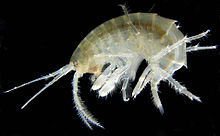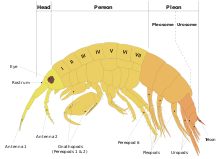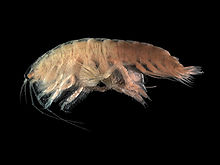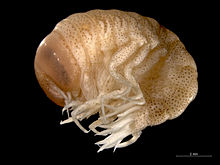Amphipoda
| Amphipoda Temporal range:
| |
|---|---|

| |
Gammarus roeselii
| |
| Scientific classification | |
| Domain: | Eukaryota |
| Kingdom: | Animalia |
| Phylum: | Arthropoda |
| Class: | Malacostraca |
| Subclass: | Eumalacostraca |
| Superorder: | Peracarida |
| Order: | Amphipoda Latreille, 1816[1] |
| Suborders | |
|
Traditional division[2]
Revised division (2013)[1] | |
Amphipoda (/æmˈfɪpədə/) is an order of malacostracan crustaceans with no carapace and generally with laterally compressed bodies. Amphipods (/ˈæmfɪpɒdz/) range in size from 1 to 340 millimetres (0.039 to 13 in) and are mostly detritivores or scavengers. There are more than 9,900 amphipod species so far described. They are mostly marine animals, but are found in almost all aquatic environments. Some 1,900 species live in fresh water, and the order also includes the terrestrial sandhoppers such as Talitrus saltator and Arcitalitrus sylvaticus.
Etymology and names
The name Amphipoda comes, via Neo-Latin amphipoda, from the Greek roots ἀμφί 'on both/all sides' and πούς 'foot'. This contrasts with the related Isopoda, which have a single kind of thoracic leg.[3] Particularly among anglers, amphipods are known as freshwater shrimp, scuds, or sideswimmers.[4][5]
Description
Anatomy

The body of an amphipod is divided into 13 segments, which can be
The head is fused to the thorax, and bears two pairs of antennae and one pair of sessile compound eyes.[6] It also carries the mouthparts, but these are mostly concealed.[7]
The thorax and abdomen are usually quite distinct and bear different kinds of legs; they are typically laterally compressed, and there is no
The abdomen is divided into two parts: the pleosome which bears
Size

Amphipods are typically less than 10 millimetres (0.4 in) long, but the largest recorded living amphipods were 28 centimetres (11 in) long, and were photographed at a depth of 5,300 metres (17,400 ft) in the
Some amphipods exhibit sexual dimorphism. In dimorphic species, males are usually larger than females, although this is reversed in the genus Crangonyx.[13]
Reproduction and life cycle
Amphipods engage in amplexus, a precopulatory guarding behavior in which males will grasp a female with their gnathopods (enlarged appendages used for feeding) and carry the female held against their ventral surface. Amplexus can last from two to over fifteen days, depending on water temperature, and ends when the female molts, at which point her eggs are ready for fertilisation.[13]
Mature females bear a marsupium, or
Diversity and classification



Over 10,500 species of amphipods are currently recognised. Suborder Gammaridea contained the majority of taxa, including all the freshwater and terrestrial species.[7] In contrast, the small suborder Ingolfiellidea only had 40 species.[16]
Gammaridea had been recognised as a problematic group in need of taxonomic revision.
The classification listed immediately below, from the rank of suborder down to superfamily, represents the traditional division as given in Martin & Davis (2001),[15] except that superfamilies are recognised here[according to whom?] within the Gammaridea. The new classification of Lowry and Meyers (2017) is shown in the cladogram.
|
|
| New Amphipoda classification of Lowry and Myers[17][19] | |||||||||||||||||||||||||||||||||||||||||||||||||||||||||||||||||||||||||||||||||||||||||||||||||||||||||||||||||||
|---|---|---|---|---|---|---|---|---|---|---|---|---|---|---|---|---|---|---|---|---|---|---|---|---|---|---|---|---|---|---|---|---|---|---|---|---|---|---|---|---|---|---|---|---|---|---|---|---|---|---|---|---|---|---|---|---|---|---|---|---|---|---|---|---|---|---|---|---|---|---|---|---|---|---|---|---|---|---|---|---|---|---|---|---|---|---|---|---|---|---|---|---|---|---|---|---|---|---|---|---|---|---|---|---|---|---|---|---|---|---|---|---|---|---|---|
|
Fossil record
Amphipods are thought to have originated in the
Ecology

Amphipods are found in almost all aquatic environments, from
The
Around 750 species in 160 genera and 30 families are
In populations found in Benthic ecosystems, amphipods play an essential role in controlling brown algae growth.[27] The mesograzer behaviour of amphipods greatly contributes to the suppression of brown algal dominance in the absence of amphipod predators.[27] Amphipods display a strong preference for brown algae in Benthic ecosystems, but due to removal of mesograzers by predators such as fish, brown algae is able to dominate these communities over green and red algae species.[27]
Morphology
Compared to other crustacean groups, such as the Isopoda, Rhizocephala or Copepoda, relatively few amphipods are parasitic on other animals. The most notable example of parasitic amphipods are the whale lice (family Cyamidae). Unlike other amphipods, these are dorso-ventrally flattened, and have large, strong claws, with which they attach themselves to baleen whales. They are the only parasitic crustaceans which cannot swim during any part of their life cycle.[32]
Foraging behaviour
Most amphipods are
Ampithoe longimana has been observed to avoid certain compounds when foraging for food.[35] In response to this avoidance, species of seaweed such as Dictyopteris membranacea or Dictyopteris hoytii have evolved to produce C11 sulfur compounds and C-9 oxo-acids in their bodies as defense mechanisms that specifically deter amphipods instead of deterrence to consumption by other predators.[35]
The incidence of cannibalism and intraguild predation is relatively high in some species,[36] although adults may decrease cannibalistic behaviour directed at juveniles when they are likely to encounter their own offspring.[37] In addition to age, the sex seems to affect cannibalistic behaviour as males cannibalised newly moulted females less than males.[36]
They have, rarely, been identified as feeding on humans; in Melbourne in 2017 a boy who stood in the sea for about half an hour had severe bleeding from wounds on his legs that did not coagulate easily. This was found to have been caused by "sea fleas" identified as lysianassid amphipods, possibly in a feeding group. Their bites are not venomous and do not cause lasting damage.[38]
See also
References
- ^ a b Lowry J, ed. (2014). "Amphipoda". World Amphipoda database. World Register of Marine Species. Retrieved 2014-05-23.
- ^ "Amphipoda". Integrated Taxonomic Information System.
- ^ "Amphipoda". Oxford English Dictionary (Online ed.). Oxford University Press. (Subscription or participating institution membership required.)
- ^ ISBN 1-876562-67-6. Archived from the original(PDF) on 2009-10-17.
- ^ Chan, Brian. "Freshwater shrimp (scuds, sideswimmers) – Class: Crustacea, Order: Amphipoda". Fly Fishers' Republic. Archived from the original on 23 March 2010. Retrieved April 7, 2010.
- ^ a b c d e f g "Order Amphipoda". Guide to the marine zooplankton of south eastern Australia. Tasmanian Aquaculture & Fisheries Institute. 2008. Archived from the original on 2008-07-20.
- ^ a b Holsinger, John R. "What are amphipods?". Old Dominion University. Archived from the original on July 20, 2011. Retrieved April 7, 2010.
- ISBN 0-8047-1045-7.
- JSTOR 1548395.
- ISSN 0967-0645.
- JSTOR 2416857.
- PMID 14667371.
- ^ ISBN 978-0-12-088462-9.
- ^ a b World Amphipoda Database. Horton, T.; Lowry, J.; De Broyer, C.; et al. (eds.). "Introduction". World Register of Marine Species. Retrieved 9 January 2023.
- ^ a b c Martin, Joel W.; Davis, George E. (2001). An Updated Classification of the Recent Crustacea (PDF). Natural History Museum of Los Angeles County. p. 132. Archived from the original (PDF) on 2013-05-12. Retrieved 2010-04-08.
- .
- ^ PMID 24699701.
- ^ S2CID 85750244.
- ^ PMID 28610392.
- ^ Horton T (2013). Lowry J (ed.). "Senticaudata". World Amphipoda database. World Register of Marine Species. Retrieved October 1, 2013.
- S2CID 196649863.
- S2CID 213609157.
- .
- ^ The species Rosagammarus minichiellus from the considerably older Late Triassic Luning Formation of Nevada was originally described as an amphipod, but subsequently reinterpreted as the right half of a decapod tail (Starr, Hegna & McMenamin 2015, The Geological Society of America North-Central Section 49th Annual Meeting [1])
- ^ National Geographic (27 March 2012). "James Cameron on Earth's Deepest Spot: Desolate, Lunar-Like". National Geographic Society. Archived from the original on March 28, 2012. Retrieved 27 March 2012.
- ^ Lowry, J. K.; Springthorpe, R. T. "Introduction". Amphipoda: Families. Australian Museum. Archived from the original on February 21, 2006. Retrieved April 5, 2010.
- ^ S2CID 54598097.
- .
- S2CID 4662681.
- ^ Minor, M. A.; Robertson, A. W. (March 5, 2010). "Amphipoda". Guide to New Zealand Soil Invertebrates. Massey University. Archived from the original on 10 May 2010. Retrieved April 7, 2010.
- ISBN 978-1-57958-399-6.
- ^ Goater, Tim (May 4, 1996). "Parasitic Amphipoda". Interactive Parasitology. Vancouver Island University. Archived from the original on July 14, 2010. Retrieved April 7, 2010.
- ^ hdl:1853/36755.
- ^ hdl:1853/34241.
- ^ S2CID 12281845.
- ^ .
- .
- ISSN 0261-3077. Retrieved 2024-01-22.
